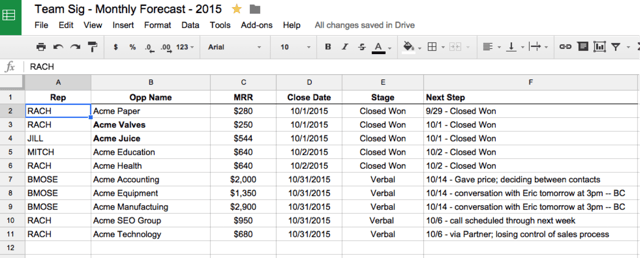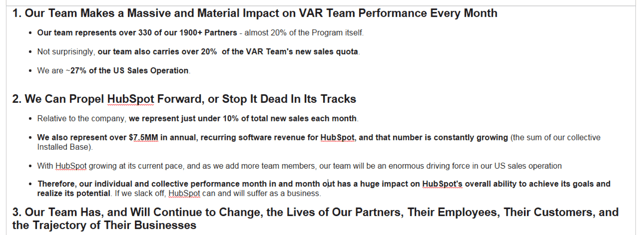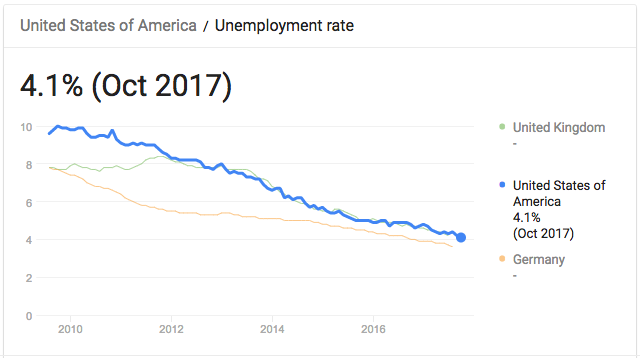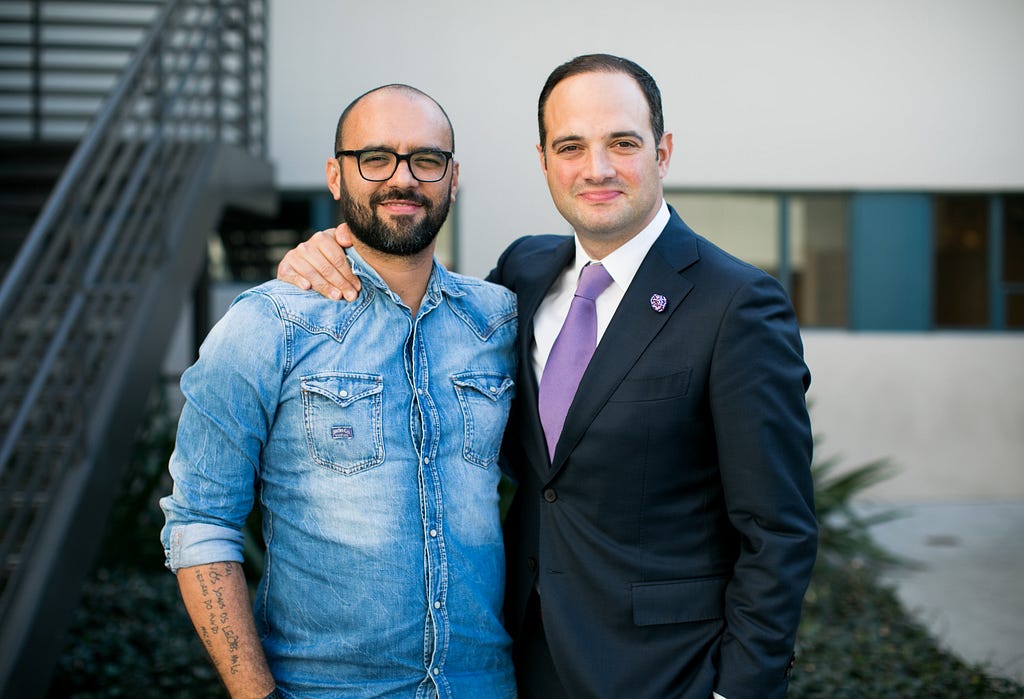So, you think you want to be a sales manager? If you’re an individual top-performing contributor in your sales organization and you’re thinking of applying for a sales manager role, let me give you a bit of a reality check first.
Here are some chilling statistics that might make you think twice about taking on a front-line manager role:
- Sales managers cannot control 83% of the metrics they're held accountable to
- A full two-thirds of all salespeople miss quota
- Over half of all salespeople close at less than 40%
- 40% of salespeople can’t understand customer pain
- Only 46% of reps feel their pipeline is accurate
- Almost half of all sales teams don’t have a playbook
- Only 52% of salespeople can access key players
If I haven’t talked you out of applying for a sales manager position, let me give you some advice, now that I’m a year into the role. Here are seven things you should know before jumping in that I wish I knew when I started.
1. Don't worry about forecasting.
For some reason I thought that accurately forecasting and reporting my team's numbers was going to be a huge obstacle to overcome. It wasn't. If you're an organized person you'll be just fine. The most difficult thing to get used to is managing a funnel of eight to 10x the opportunities you’re used to managing as an individual.
There are a few things I do to make sure I’m forecasting accurately. First, I’m always inspecting our CRM to ensure that my salespeople are logging their activities and updating stages on opportunities. Second, I ask my salespeople to tell me which deals are close-able within the month, as well as the next 60 days. This way, I can pay closer attention to these deals, and coach on the opportunities that will have an impact on my team’s attainment in the short and slightly-longer term.
If you don’t have all of this information logged in your CRM, here’s a spreadsheet template you can use:

2. Spend more time recruiting in the beginning.
If I could turn back the clock, I would have reallocated a far greater amount of my time to recruiting for my team. While I'm biased, I truly believe in Bill Belichick’s (head coach for the New England Patriots) mantra that you have to have the right people on the right bus to achieve great results.
If you're not doing it already, I would highly recommend spending the equivalent of at least one day per week interviewing and meeting with potential new candidates for your team -- regardless of whether or not you end up managing them directly.
Salespeople are famously focused on the next month or the next quarter. But, rarely do reps worry about setting themselves up for success nine or 12 months out. A sales manager, however, must think 12, or even 24 to 36 months ahead. Essentially, a sales manager must work on exceeding two numbers: their hiring targets and effectiveness, as well as sales targets.
I’ll paint this picture another way. There are two things a salesperson can screw up that causes them to miss their quota. The first is not putting enough opportunities into the top of the funnel. The second is spending too much time on deals that ultimately fall out of their funnel -- closed-lost.
The same thing can happen to a sales manager when it comes to recruiting. Continuously source enough candidates into your funnel. The key here is to build up a funnel of passive candidates that you can recruit when you’re allowed to make that next hire, or need to fill that open spot.
3. Build team unity even outside the office.
To me, managing a team of salespeople is like coaching a team of tennis players or golfers. Everyone may work on the same team, but they all have individual numbers. How do you create cohesion among the team?
If the team doesn't feel like they know everyone, they're not going to go that extra step to help one another. My advice: Make sure you spend time together and get to know one another. Plan team outings, team dinners, breakfasts, service events, etc. -- anything that enables the team to get closer to one another outside of work will pay dividends. And remember, If you turn over 20-30% of your team in a year, that means your team is always changing. So, make sure you’re planning events regularly.
Here’s my team at our holiday potluck.

4. Get better at time management.
Stepping out of "the funnel" and into the sales management role, I imagined that my days would be easier and less stressful. I wouldn’t have an individual number on my head and I would be responsible for coaching my team. Seemed simple enough.
I was dead wrong. Instead of one number, I had 10. Instead of $500,000 for my quota, I had $4 million. Instead of having more time, I had less. My time was not my own. I had to figure out which activities to prioritize quickly.
For me, the activities that I determined would have the biggest impact on performance fell into three buckets:
-
Coaching. What am I doing on a 1:1 basis to help my team members achieve their goals?
-
Scaling. What training can I facilitate that will help the majority of my team members perform better? Can I train them on things like selling skills, product knowledge, time saving tools, etc.?
-
Recruiting. What am I doing to continuously build the future success of the team?
5. Define, share, and reinforce your sense of higher purpose early.
My personal opinion is that sales reps get a bad rap. Many think that we're just out for money. We don't care how many people we burn, and we're all slick talkers.
While I think there are certainly bad reps out there that fit the old "Always Be Closing" profile, I don't think that most reps are like that. Instead, I think most reps actually want to understand why their work is meaningful and what purpose it serves. This thinking is backed by a variety of sales consultants and leaders, and exemplified well in an article by Next Level Sales Consulting. Here’s a quote that jumped out to me:
“Salespeople who are intrinsically motivated are more fulfilled and financially successful than extrinsically motivated salespeople.”
Still don’t believe me? There’s some great research from Dave Kurlan and his team at Objective Management Group, highlighted in this article:
“In the old days (pre-2008), if salespeople were motivated, then they were probably motivated by money. According to data from Objective Management Group, 54% of salespeople were money-motivated during the 1990s and first half of the 2000s. Today, the data shows that no more than 27% of salespeople are what we now call extrinsically-motivated.”
When moving into a sales manager role, you're also choosing to enter a leadership role. While anyone can be a leader -- and hopefully you have a few on your team -- leadership is a mandatory part of the sales management position. If you cannot define your team’s or company’s sense of purpose as a leader, you should work on it. Defining, sharing, and reinforcing that vision on a regular basis will constantly remind your team that the work they're doing matters.
If you're struggling to define your team’s higher purpose, think deeply about why your company was formed in the first place. What challenge did it solve? What challenges do you solve now? How does this make your customers' lives better? How does this make the world a better place?
Be specific! Quantify wherever you can. Salespeople love numbers. Here’s an excerpt of an email I sent to my team on the vision and our purpose working together (I sent this within the first 45 days of building my team in 2014):

6. Remember, your direct reports are not 'mini-mes.'
This is something I still struggle with to this day. The truth is, many sales leaders will coach and manage their team the same way in which they were coached or liked to be coached. If you were direct and to the point with your manager, odds are that you'll want that out of your reps too.
However, the key here is not to follow the "Golden Rule" and "Treat others how you would want to be treated"; instead, follow the "Platinum Rule", and "Treat others how they want to be treated." I know this is easier said than done, but there are a lot of training assessments out there to help. Get your company to give you the tools you need to succeed by enrolling in training sessions or classes on communication styles. I personally found the Intelligent.ly Manager Exchange Training incredibly helpful in my early months as a manager.
7. Give time to new-hire onboarding.
In my first two months as a manager I had to hire three new team members. It was a lot. Your new hires need just as much if not more of your mindshare compared to more tenured, or possibly inherited reps. So what is a new manager supposed to do!?
First, make sure you clearly lay out expectations for your new hire, what milestones they should be hitting by when, and show them the resources and training you're going to provide to help get them there.
Second, consider asking your more tenured team members to be peer mentors. I find most people actually like paying mentorship forward since most great reps had a mentor that got them where they are today. This will ease some of the stress on your time.
And third, set up a regular cadence of small group coaching sessions. I would recommend twice per week as mandatory and twice per week as optional, allotting one hour for each of the four sessions. These are not designed to replace your one-on-ones -- they should be in addition to that time.
8. View your team's performance as a reflection of your own.
Wanting to take credit for the victories and avoid blame for the losses is human nature. But as a sales manager, you can’t pass the buck. The performance of your reps is a reflection of your performance as a manager.
When team members asked me the same question for the tenth time, I had to accept it wasn’t their failure to remember and absorb the information -- it was my failure to properly communicate it.
When reps missed their monthly quota, it wasn’t their failure to sell -- it was mine for not making sure they were prospecting enough, adding value to their prospects, following up quickly, finding win-win solutions, and so on.
I realized I cannot care about anyone else's success more than they do. I also needed to face the reality that systemic problems on my team were probably caused by my coaching … or lack of.
9. Don't try to be the 'Chief Problem Solver.'
During my first two years as a sales manager, reps came to me with challenges multiple times per day. I was always being pulled into difficult situations -- both with customers and internally. I thought solving these issues was part of doing my job. Yet after a while, I realized this approach did more harm than good.
I needed to enable my reps to think for themselves and learn key skills on their own, or else they’d always be dependent on me.
Now I require my team members to think critically and come to the answer with me, rather than immediately jumping to give it to them.
There are still some situations where a quick answer is necessary -- like if your rep is on a call and presses Mute to ask you something -- but those are the exception, not the rule.
10. Ask questions instead of giving orders.
After I learned the last lesson, getting buy-in from my team actually became much easier. Why? Because when you tell people what to do, they’re typically a little resistant. When a solution is their idea, they’re far likelier to believe in (and therefore act on) it.
For example, suppose one of my salespeople said, “Sig, I’m having trouble with this opp. A new decision maker got involved at the last minute and she’s pushing for the competitor’s product. What should I do?”
I’d be tempted to offer my opinion; after all, it’s flattering when someone asks for your “wisdom.” However, I’ve learned I must avoid this trap. Instead, I’d turn the question around:
“Well, I'm happy to share what I think, [rep’s name], but since you're so much closer to the situation, you probably know best what the next step should be. What's your opinion on what we should do next?”
Sometimes, the rep starts brainstorming ideas. Sometimes, they get frustrated and say, “I don’t know, that’s why I’m asking you!”
Don’t let this sway you. I’d say, “Ok, you don't know ... [PAUSE] ... If you DID know, what do you think that might sound like?” A slightly less tongue-in-cheek response is: "If I weren't here, what would you do?”
Typically this breaks the tension and gets the rep to smile or even laugh. They’ll offer an idea, you can give feedback, and so on, until you’ve hit on an effective strategy. And best of all, you’ll give them a framework to solve problems for themselves.
How to Convince Sales Leadership You’re Ready to Manage
Assuming I haven’t dissuaded you from becoming a sales manager, your next step is to apply for the job. A big part of getting the job is showing that you’re prepared. In most companies, as long as you’re consistently over-performing, you can probably start to do some of the activities above. You can certainly help plan team outings, mentor newer salespeople, help your manager source new candidates for the team, and maybe even improve team forecasting. You can even start to lead by sharing why sales and your company help you fulfill a higher purpose. I’ve always found that assuming the responsibility is the best way to earn it.
Finally, if your company offers training programs on preparing for management, or will even sponsor you to go to training sessions like Intelligent.ly, take full advantage of the opportunity. The more you can surround yourself with peers with similar ambitions and experiences, the more likely you’ll be successful.
Statistic sources: Jason Jordan, Salesforce




























%20-%20Final-1.jpg?t=1522203464426&width=1125&name=Close-Mailshake-Vidyard%20Webinar%20Graphic%20(Featured%20Meta%20Image%20for%20Page)%20-%20Final-1.jpg)

